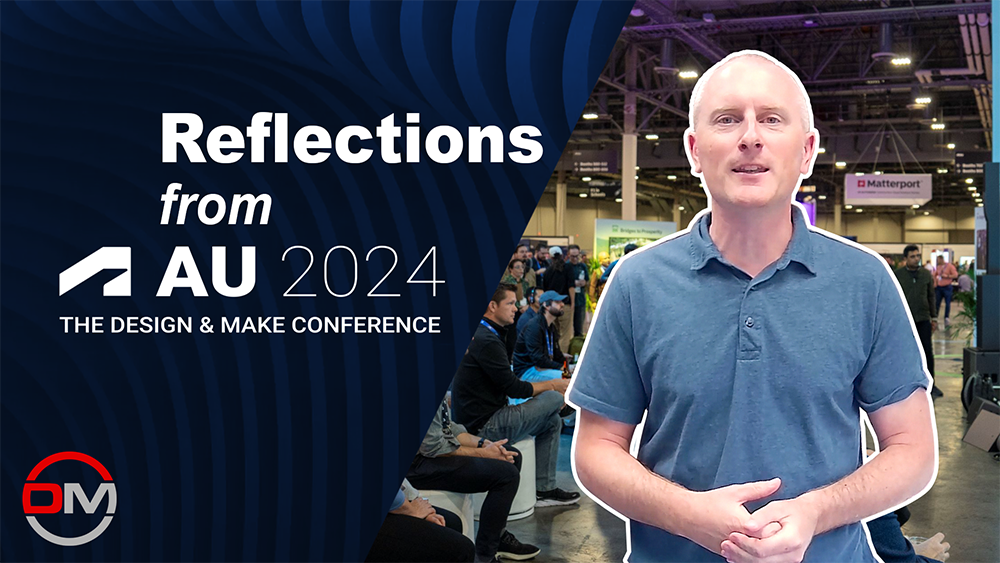I recently returned from Autodesk University 2024, which I attended with our team on the expo floor, highlighting our electrical design software add-in for Revit, ElectroBIM. It has been a while since my last visit in 2001 as an attendee and then with a booth in 2002. This year, I had the pleasure of meeting with a variety of industry professionals, watching sessions from one of the nearby presentation stages, and catching up on the latest trends.
Why We Attended Autodesk University
Autodesk University is a huge gathering of professionals from a range of industries, from architecture and engineering to media and manufacturing. The conference includes keynote presentations from Autodesk executives, smaller in-depth classroom sessions on specific products, and an expo floor where a diverse mix of companies (including ours) exhibit innovations built on the Autodesk platforms.
The booth we selected was set up directly across from one of the expo’s main presentation stages, so while I did not sit for many sessions in person, I was able to observe and listen to several presentations. Autodesk also live-streamed the main stage presentations to the expo floor, allowing me to keep up with keynote announcements and ongoing trends while setting up each morning.
Key Themes for 2024: AI and AECO
The primary themes from the presentations this year centered on two major areas: Artificial Intelligence (AI) and AECO—an expanded term for the industry that adds “Operations” to Architecture, Engineering, and Construction.
AI is the hot topic right now, with Autodesk and other software companies working to incorporate it into meaningful applications. But despite the excitement on display, there is still a long road ahead to make AI practically useful for construction and building design. For now, AI remains a broad vision, with specific applications still in development.
As for AECO, this new term reflects Autodesk’s focus toward lifecycle management, aiming to extend BIM beyond design and construction and move to the ongoing maintenance and operations of buildings. While this concept is compelling for long-term project oversight, the relevance is still limited for many of us in electrical engineering.
Expo Floor Insights: Customization, Innovation, and Networking
One of the highlights of the expo floor was the industry-specific case studies presented by various companies. These studies showcased impressive Revit implementations, like using models for prefabrication or onsite assembly. However, one theme stood out—these advanced workflows often relied on significant in-house customization, which can be hard to translate across companies. While Autodesk provides a platform with vast customization capabilities, replicating these processes in another company is not always that easy.
For companies without extensive in-house development, third-party software solutions like ours play a crucial role. Companies like Design Master are there to make advanced workflows possible without extensive development time. Our booth welcomed a steady flow of BIM managers and professionals interested in enhancing their electrical workflows with ElectroBIM, especially those from large firms who often work closely with electrical engineers or who understand the need for additional Revit electrical features like single-line diagrams and voltage drop.
Noteworthy Solutions on Display for Electrical Engineers
While Autodesk University is not heavily attended by electrical engineers specifically, there are a few solutions showcased this year that are relevant for those of us in the field:
- Siemens BIM Power: Siemens introduced a new tool for Revit, BIMPOWER, which offers features for electrical modeling, specifically addressing the need for better handling of bus ducts. Bus ducts are notoriously complex to model in Revit, so for those in need of effective drafting solutions, BIM Power is worth exploring.
- Ripple: Ripple is an automation tool designed for mechanical engineers, particularly in HVAC layout and load calculations. While this is not an electrical tool, if you work with mechanical designers or HVAC teams, Ripple could be beneficial for streamlining their workflows in Revit.
For Electrical Engineers Considering Autodesk University
If you are an electrical engineer thinking about attending Autodesk University, here is what to expect: while you may not find many of your direct peers, there are valuable sessions on Revit and BIM that can enhance your expertise. Register early, as popular classes fill up quickly. Attending Autodesk University also offers an opportunity to connect with other developers and software companies, discuss new tools and techniques, and get hands-on with software tailored for your field.
For us, Autodesk University 2024 was a fantastic event for showcasing our work, networking with BIM managers, and learning about upcoming trends and technologies. We are looking forward to returning in 2025 and hope to see you there. Whether you are looking for innovations in Revit, want to discuss best practices in electrical design, or are seeking software solutions like ElectroBIM, there is a lot to gain and connections to make at Autodesk University.
Join Our Free Webinar
April 16, 2025 • 1:00 ET / 10:00 PT
“Create Single-Line Diagrams in Revit Without Late Nights or Change Orders”

